Samsung Fascinate Review: Verizon's Galaxy S Smartphone
by Brian Klug on October 5, 2010 12:01 AM EST- Posted in
- Smartphones
- Samsung
- Galaxy S
- Fascinate
- Mobile
Performance
Anand declared the Epic 4G the fastest Android phone. I think it's safe to say that right now the Galaxy S is the undisputed performance champ for 3D, at least until we start seeing SoCs built around A9 MPCore with even more powerful GPUs. CPU wise, Hummingbird is running the same architecture ARM Cortex A8 at 1 GHz that we've seen in other SoCs. For now, the Fascinate's Hummingbird SoC with the PowerVR SGX 540 GPU is really what sets it apart. It's a significant improvement over the SGX 530/535, and if you haven't already, I'd encourage you to read what Anand had to say about it in the Epic review.
That improvement is readily apparent in Quake III, where the Fascinate posts unsurprisingly similar numbers to the Epic.
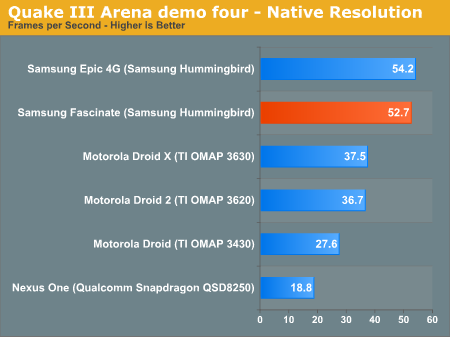
Likewise, we get similarly impressive Neocore numbers out of the Fascinate, which is Qualcomm's benchmark for showing off Adreno.
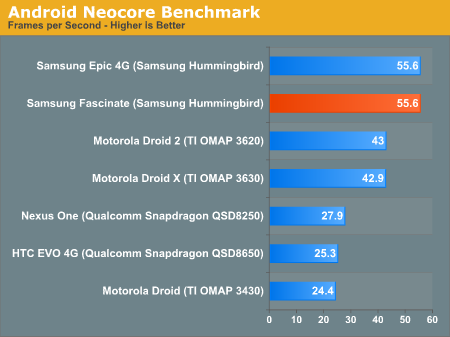
Though most of Android still can't take advantage of the SGX 540, applications that are rendered using OpenGL do show a massive performance boost. The qualitative difference between the stock Android gallery application on the Nexus One compared to the Fascinate is huge. On the Nexus One, it feels occasionally slow and choppy, yet on the Fascinate it's beyond smooth.
When the Android UI finally gets GPU acceleration, that huge performance gain will be readily apparent in everyday use instead of locked away for 3D apps and games.
Of course, our CPU-bound tests show almost exactly what you'd expect from a 1 GHz Cortex-A8. Bear in mind the Fascinate is running Android 2.1 as of these tests, but you can see how much Android 2.2 changes things - in some places.
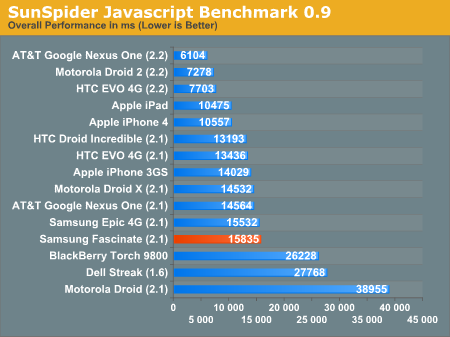

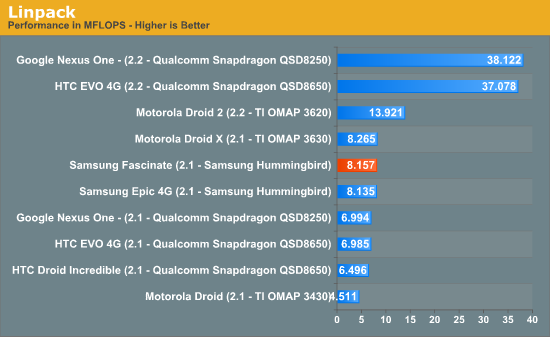
As an aside, I talked in the Droid 2 article about how I didn't quite understand why Linpack performance on Android 2.2 on the OMAP 3620 SoC wasn't what I expected it to be. The comparison I was using was to all the smartphones I had previously seen with Android 2.2 - all of which were Qualcomm Snapdragon SoC based with Scorpion CPUs at the core. The Droid 2 was my first encounter with a relatively standard Cortex-A8 running Android 2.2 with the JIT/NEON optimizations.
As some of our readers noted, the reason that Linpack performance on the Droid 2 isn't as high is simple - Scorpion has faster FPU performance due to a 128 bit SIMD FPU datapath compared to Cortex-A8's 64 bit implementation. Both FPUs process the same SIMD-style instructions, the Scorpion just happens to be able to do twice as much, or optionally turn off half the datapath to save power.
The reason I bring this up is that we won't see as dramatic a change in benchmarks that are FPU/NEON heavy moving from Android 2.1 to 2.2 on the Fascinate. Modest gains are in order all around, but not the dramatic floating point performance boost that really doesn't translate into huge performance gains elsewhere.
I've also been doing the regular suite of page loading tests. Though the Fascinate lacks Flash and the faster browser that 2.2 brings, it renders pretty quickly:
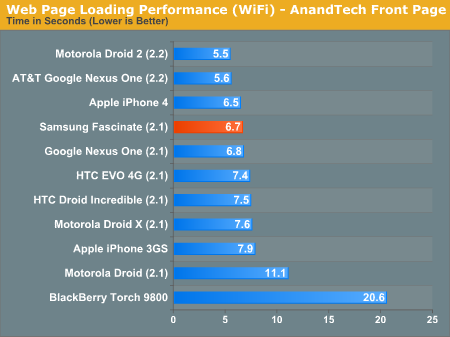
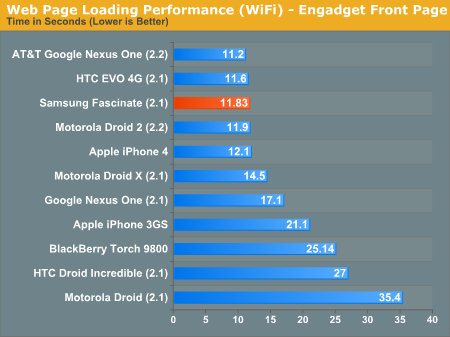










73 Comments
View All Comments
netmasterjohn - Tuesday, October 5, 2010 - link
How come Fascinate & Nexus One video are the same?dman - Tuesday, October 5, 2010 - link
I appreciate the testing methodology including the GPS fix times. I had an ATT Tilt (HTC 8925) which was notoriously slow in getting locked in. I got into the habit of starting the GPS app as soon as I'd get outdoors so that by the time I'd get to my vehicle it'd only have a couple minutes left. That and a few other workarounds. Sad that they still have issues these days...Chadder007 - Tuesday, October 5, 2010 - link
My Droid X came with a 16GB card, not 8.chemist1 - Tuesday, October 5, 2010 - link
Brian: Thanks for your reply. I'm pleased to hear you're trying to move in that direction. The idea of playing with CDMA voice codecs is intriguing -- I didn't occur to me that the audio quality (AQ) of smart phones could actually be user-modifiable at the software level. Though much of what determines AQ is hardware—the quality of the speaker in the earpiece, the circuitry upstream of it (and at the headphone jack output), the quality of the microphone (for those on the receiving end of your call), etc.More broadly, I like your general program of trying to put all areas that are now subjective onto a more objective footing. The problem with doing that for AQ is that it’s tricky. Often something can measure well, yet sound mediocre—which typically means that the measurements being used aren’t the right ones (for instance, maybe you’re measuring distortion, but the real problem is a phase error); or, alternately, perhaps the measurements aren’t being weighted properly. One solution is to supplement measurements with purely subjective, yet controlled, observations (a listening panel). You could also evaluate audio under compromised conditions by checking word recognition accuracy (but the danger here is that what might help accuracy under poor conditions—say, a boosted upper midrange—might make the phone fatiguingly harsh to listen to under normal conditions). Beyond that, I’d just reiterate what I said in my first post—I’d advise bringing in someone with a trained ear and/or lots of audio testing experience (if that's possible). [You can test for a trained ear by seeing if he/she can distinguish between different codecs in a single-blind test; or, alternately, perhaps you know, say, a recording engineer or a good classical pianist.]
Also, if you would, please ask Anand to read the Heijligers link I posted in my last comment, before he next tests iPods! [And you or he might wish to test the Redwine modification available for the 4G–5.5G iPods (http://redwineaudio.com/products/imod), to hear for yourselves what difference improved output circuitry can make in PMP AQ.]
Ranari - Tuesday, October 5, 2010 - link
*NOTE TO AUTHOR*Verizon and Microsoft have an advertising contract between each other, which is why you see Bing plastered all over the Samsung Fascinate. Businesses can control mobile ads in the Bing search engine using the Microsoft Adcenter. Mind you, this is over the Verizon network, but you can also see a few Bing mobile ads on m.bing.com, or if you download the Bing app on your smartphone. If you want a more Google experience, the other carriers will probably be your thing, but I find it to be more of an extension of the Android OS.
Personally, I think Bing has a pretty awesome mobile platform.
Aside from that, the review perfectly matches up with my thoughts about my Samsung Vibrant (T-Mobile).
-The Super AMOLED is absolutely gorgeous.
-The GPU is overkill, and I like it that way.
-Performance is great
-Battery life is mediocre
-And the GPS sucks bizalls
Cheers!
silverblue - Wednesday, October 6, 2010 - link
Sorry, didn't mean to be picky. :)anaxagoras1986 - Wednesday, October 6, 2010 - link
I'm not sure how the Galaxy is clearly better. It has a better GPU which is great, but only if you can use it. I don't play games so GPU performance is less important to me.Real-world performance with an Incredible (all of which are 2.2 now, why are you still testing or showing 2.1 results?) is close to the Nexus One 2.2 and HTC Evo 2,2. The charts show the 2.2 phones with a substantial performance advantage over the Galaxy.
So how is the Galaxy clearly better?
Doppleganger77 - Wednesday, October 6, 2010 - link
Even applying just the lag fix (fixes file system) to a 2.1 Galaxy S dramatically increases performance. For example, in the Quadrant benchmark I routinely achieve over 2200 points compared to about 800 for a standard Galaxy S. The Nexus One 2.2+ by comparison achieves around 1300 points. By applying a one click solution this phone can fly.ezinner - Thursday, October 7, 2010 - link
Arghh! I love the Galaxy S phones, but why oh why can't they put phone function buttons on the phone? Remember that this is still a phone and the most common functions are answer and end call!Jumpman23 - Saturday, October 9, 2010 - link
I always thought the iPhone ran at 1 GHz. So is 800MHz a typo or...